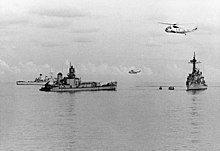
HMAS Melbourne (R21) was a Majestic-class light aircraft carrier operated by the Royal Australian Navy (RAN) from 1955 until 1982, and was the third and final conventional aircraft carrier to serve in the RAN. Melbourne was the only Commonwealth naval vessel to sink two friendly warships in peacetime collisions.
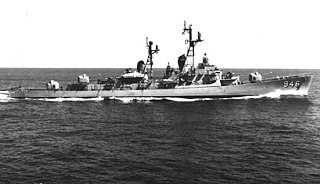
USS Edson (DD-946) is a Forrest Sherman-class destroyer, formerly of the United States Navy, built by Bath Iron Works in Maine in 1958. Her home port was Long Beach, California and she initially served in the Western Pacific/Far East, operating particularly in the Taiwan Strait and off the coast of Vietnam. Her exceptionally meritorious service in 1964 in the Gulf of Tonkin was recognized with the first of three Navy Unit Commendations. During the following years she was shelled by North Vietnamese land forces, and apparently received friendly fire from the US Air Force.

USS Stribling was a Gearing-class destroyer in the United States Navy. She was the second US Navy ship named for Admiral Cornelius Kincheloe Stribling.

USS Collett (DD-730) was a World War II-era Allen M. Sumner-class destroyer in the service of the United States Navy.

HMAS Sydney (R17/A214/P214/L134) was a Majestic-class light aircraft carrier operated by the Royal Australian Navy (RAN). She was built for the Royal Navy and was launched as HMS Terrible (93) in 1944, but was not completed before the end of World War II. The carrier was sold to Australia in 1947, completed, and commissioned into the RAN as Sydney in 1948.

HMAS Perth was the lead ship of the Perth-class guided missile destroyers operated by the Royal Australian Navy (RAN). Built in the United States to a modified version of the Charles F. Adams design, Perth entered service with the RAN in 1965.

HMAS Brisbane was one of three Perth-class guided missile destroyers to serve in the Royal Australian Navy (RAN). The United States-designed ship was laid down at Bay City, Michigan in 1965, launched in 1966 and commissioned into the RAN in 1967. She is named after the city of Brisbane, Queensland.

USS Taussig (DD-746) was an American Allen M. Sumner-class destroyer. It was named for Edward D. Taussig, a rear admiral of the United States Navy whose career spanned over 50 years. Adm. Taussig is remembered for claiming Wake Island for the United States on January 17, 1899 while commanding the gunboat Bennington and for accepting the physical relinquishment of Guam from Spain, ending 300 years of Spanish colonial rule.

USS Harry E. Hubbard (DD-748), was an Allen M. Sumner-class destroyer of the United States Navy.

USS Norris (DD-859) was one of 98 Gearing-class destroyers in the United States Navy during the end of World War II. Norris was active from 9 June 1945 to 4 December 1970. Although built too late to see action during the war, the ship served in the Pacific, Atlantic, Asiatic, and Mediterranean areas.

USS McKean (DD-784) was a Gearing-class destroyer of the United States Navy built by the Todd Pacific Ship Building Company in Seattle, Washington state.

USS Wiltsie (DD-716) was a Gearing-class destroyer in the United States Navy. She was named for Irving Wiltsie. The destroyer entered service in 1946 and remained active with the United States Navy until 1977, when Wiltsie was decommissioned and sold to Pakistan in 1977. The vessel entered service with the Pakistan Navy as PNS Tariq (D165) in 1978. In 1990, the ship was renamed PNS Nazim to allow the name Tariq to be given to a newly-acquired Type 21 frigate. The ship was then transferred to the Pakistan Maritime Security Agency and used as an alongside "at sea" headquarters for the agency. Though afloat, the vessel no longer sails.
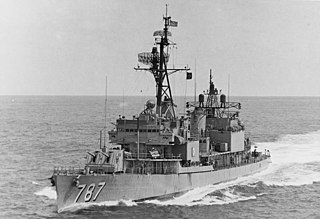
USS James E. Kyes (DD-787) was a Gearing-class destroyer of the United States Navy, named for Commander James E. Kyes (1906–1943).
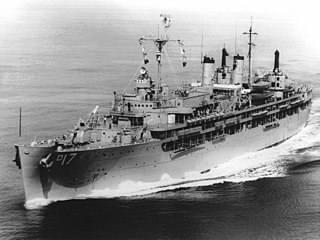
USS Piedmont (AD–17) was a Dixie-class destroyer tender built during World War II for the United States Navy. Her task was to service destroyers in, or near, battle areas and to keep them fit for duty. She served in the Pacific Ocean during World War II, the Cold War, the Korean War, and the Vietnam War. For her work in battle areas, the ship was awarded four battle stars for her Korean War efforts and one for Vietnam War service.

USS Tawasa (AT-92) was a Cherokee-class fleet tug constructed for the United States Navy during World War II. Her purpose was to aid ships, usually by towing, on the high seas or in combat or post-combat areas, plus "other duties as assigned." She served in the Pacific Ocean and had a very successful career marked by the winning of three battle stars during World War II, two during the Korean War, and seven campaign stars during the Vietnam crisis.

The Melbourne–Evans collision was a collision between the light aircraft carrier HMAS Melbourne of the Royal Australian Navy (RAN) and the destroyer USS Frank E. Evans of the United States Navy (USN). On 3 June 1969, the two ships were participating in SEATO exercise Sea Spirit in the South China Sea. Around 3:00 am, when ordered to a new escort station, Evans sailed under Melbourne's bow, where she was cut in two. Seventy-four of Evans's crew were killed.

A plane guard is a warship or helicopter tasked to recover the aircrew of planes or helicopters which ditch or crash in the water during aircraft carrier flight operations.
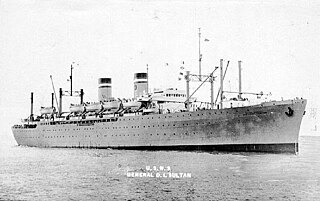
USS Admiral W. S. Benson (AP-120) began as an unnamed transport, AP-120, that was laid down on 10 December 1942 at Alameda, California by the Bethlehem-Alameda Shipbuilding Corp., under a Maritime Commission contract. She was named Admiral W. S. Benson (AP-120) on 20 October 1943 and launched on 22 November 1943; sponsored by Miss Dorothy Lucille Benson, granddaughter of the late Admiral William S. Benson. She was accepted from the Maritime Commission on 23 August 1944 and commissioned the same day.
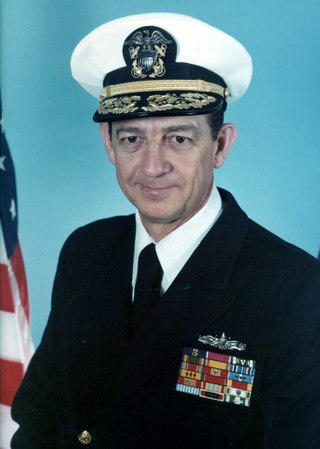
Vice Admiral Emmett Hulcy Tidd was a flag officer of the United States Navy.


